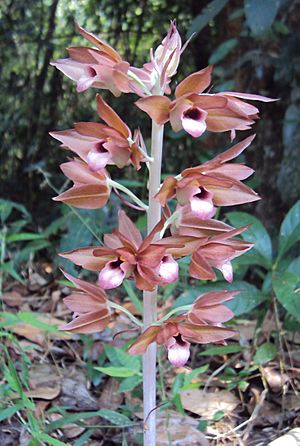Carrion orchid facts for kids
Quick facts for kids Carrion orchid |
|
|---|---|
 |
|
| Eulophia zollingeri near Kottiyoor, India | |
| Scientific classification | |
| Genus: |
Eulophia
|
| Species: |
zollingeri
|
The Eulophila zollingeri, often called the carrion orchid, is a special plant. It belongs to the orchid family. You can find it in warm, wet places from tropical and subtropical Asia all the way to Queensland, Australia. This orchid is quite unique because it doesn't have green leaves. Instead, it's a brownish plant that grows on the ground, often in decaying wood. It can have up to forty reddish-brown flowers. These flowers have a strong, sharp smell and a dark red and yellow lip.
What Does the Carrion Orchid Look Like?
The carrion orchid is a plant that grows on the ground. It has a special underground part called a pseudobulb, which stores food and water. Unlike most plants, it doesn't have green leaves. Instead, its flowering stem has thick, pointed bracts.
This orchid can grow between six and forty reddish-brown flowers. Each flower is about 40–50 mm (1.6–2.0 in) long and 50–60 mm (2.0–2.4 in) wide. The whole flowering stem can be quite tall, reaching 400–900 mm (20–40 in).
The flowers have a strong, unpleasant smell. This smell helps to attract insects that pollinate the plant. Each flower has different parts:
- The top petal, called the dorsal sepal, is shaped like an oval. It is about 15–23 mm (0.6–0.9 in) long and 4–7 mm (0.2–0.3 in) wide. It curves forward.
- The side petals, called the lateral sepals, are more oblong. They are about 16–25 mm (0.6–1 in) long and 6–9 mm (0.2–0.4 in) wide, with a pointed tip.
- The other petals are shaped like a spearhead. They are about 11–18 mm (0.4–0.7 in) long and 5–7 mm (0.2–0.3 in) wide.
- The most noticeable part is the labellum, or lip. It is dark red with yellow on the outside. It's about 14–15 mm (0.55–0.59 in) long and 15–18 mm (0.6–0.7 in) wide. The labellum has three parts, or lobes. The middle lobe curves down and has short, thick hairs. The side lobes stand upright.
In Australia, these orchids usually flower between December and February. In China, they flower from April to May.
How Did the Carrion Orchid Get Its Name?
The carrion orchid was first officially described in 1857. A scientist named Heinrich Gustav Reichenbach gave it the name Cyrtopera zollingeri. He published his description in a scientific paper called Bonplandia.
Later, in 1905, another scientist named Johannes Jacobus Smith changed its name to Eulophia zollingeri. This is the name it is known by today.
Where Does the Carrion Orchid Live?
The Eulophia zollingeri orchid likes to grow in and around the edges of rainforests. It especially likes places where there is rotting wood.
You can find this unique orchid in many countries across Asia and Australia. These include China, Taiwan, India, Indonesia, Japan, Malaysia, New Guinea, the Philippines, Sri Lanka, Thailand, Vietnam, and tropical northern Queensland in Australia.

